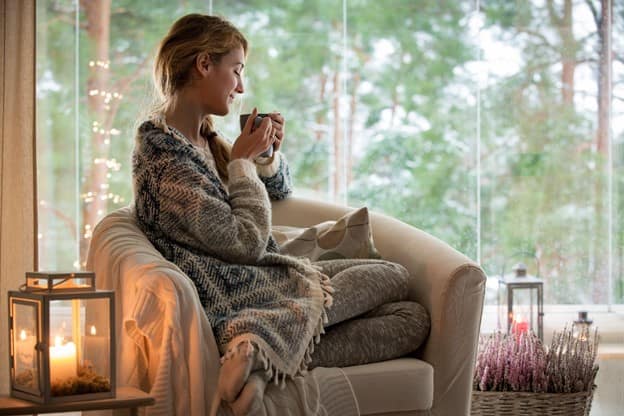The cold weather is here, and many homeowners are struggling to keep their homes as warm as they would like. An Energy Saving Trust survey tells a different story.
Most people reluctantly reach for additional covers and jumpers when they feel the chill. Nonetheless, there are simple ways to keep your house warm for a longer period with energy-efficient measures.
In the winter, 52% of people wear jumpers and almost 40% wrap themselves in blankets, but only 16% of homeowners insulate their pipes. In addition, few people bleed their radiators, causing cold spots throughout their homes.
Energy consumption for heating homes accounts for more than 70 per cent.
Reducing this figure while still keeping homes warm allows governments to meet their carbon reduction targets while reducing energy bills.
The following are clever ways that you can keep your house warm without spending extra money – just in time for those severe weather warnings.
Curtains are very important
Take advantage of the free heat that the sun provides. Allow the sunlight to enter your home during the day so that you can benefit from its free heat. Keep your curtains closed when it gets dark to keep warmth in your rooms. They act as another layer of insulation. Making sure there are no leaks or gaps will allow warm air to stay in and cold air to escape. This will also help reduce condensation.
Make use of your heating system’s timers
It is more cost-effective to turn your boiler on 30 minutes earlier when you wake up so that your heating is off at a lower temperature rather than immediately after you wake up. It does not matter whether you set your boiler to 20°C (68°F) or 30°C (86°F), the boiler will heat up at a constant rate. You should not, however, leave your heating on low during the day – because then you are paying for heat you don’t need.
Adjust your furniture and sofa
If you like to relax on your favourite seat in front of the radiator, consider how much heat it might be absorbing. As the hot air can circulate freely away from the radiator, it can be moved. You should also keep curtains or clothes drying away from radiators to make sure you get the most out of your heating.
Insulate as best as you can
Heat is lost through the roof to the tune of 25 per cent. It is easy to reduce this by installing 25 cm of insulation throughout your loft. Additionally, having an uninsulated home loses around one-third of its heat through the walls. Cavity wall insulation won’t be as cheap as loft insulation, but it can result in savings of up to £160 in heating bills a year. Additionally, you may want to check with your energy provider for any insulation schemes that may be available – which can sometimes mean cheap or free installation.
Maintain your water temperature warm
If you have a hot water tank, make sure it is properly lagged – or insulated. This will keep the water warmer for longer, and reduce heating costs. The Energy Community reckons that insulating an uninsulated water tank could save up to £150 ($185) a year – but even just upgrading your tank’s ‘old jacket’ will help to save money.
Moderate your house temperature
Although this seems counterintuitive, it is essential. A minimum temperature of 21°C (70°F) is recommended in the living room, but this is now 18°C (61°F). You can reduce your heating bill by as much as 10% by turning your thermostat down by just 1°C. The best temperature to keep your home at is 18°C (61°F), saving you money and reducing the negative impacts of a cold home.
Draughts should be kept out
It is possible to keep the warmth in your home by creating your own sausage dog draught excluder. It is estimated that DIY draught-proofing your doors, windows and cracked floorboards can save you up to £30 per year. Performing this task yourself will cost you very little money. Inexpensive and easy to install are self-adhesive rubber seals around windows and doors as well as door draught excluders. Therefore, before winter kicks in, those doors and windows should be sealed up.
Heater thermostats need to be installed
Recent studies have found that installing thermostatic radiator valves and heating controls can save 40 per cent more energy than a house without controls.
You can program these systems so that your heating automatically comes on at predefined times, saving you energy and money.
Smart thermostats can also be controlled remotely through your smartphone, allowing you to turn on your heating on your way home to ensure it’s warm when you get there.
Invest in a new boiler
Purchasing a new, the more energy-efficient boiler might make sense if your boiler is more than 10 years old. A new condensing boiler that’s both A-rated and efficient can save you as much as £350 ($433). They use less energy than older boiler types, more efficiently heating your home. In addition, a new heater will be less likely to malfunction during the winter.
Heat Reflection
The panels on radiators are relatively cheap, easy to install and ensure that the heat from the radiators warms your room rather than your walls. Reflectors use heat to heat a room again.
Final Thoughts
The three biggest heating safety blunders
Heating indoors can be dangerous in some instances, but some heating techniques are downright lethal.
- Carbon monoxide is emitted as heat beads and BBQ briquettes burn, so these should not be used indoors.
- The use of gas heaters in small rooms, such as bedrooms, is not recommended due to their emissions.
- Don’t use outdoor gas heaters indoors or use gas stoves or cooktops as heaters – they aren’t meant for that purpose and give off more carbon monoxide (gas stoves and cooktops don’t have the same filters as indoor gas heaters).




